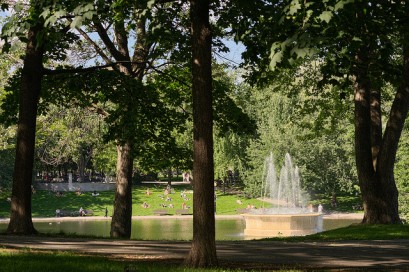Field notes: Parc la Fontaine, Montreal

VPSN contributor Eva Kwan shares recollections – and a few photos – from one of her favourite greenspaces, the extraordinary Parc la Fontaine in Montreal. (Feature image: Mire de rien)
In Montreal, bounded by Rues Rachel and Papineau and Avenue Sherbrooke, is beautiful Parc la Fontaine. Located in the popular Plateau neighbourhood, it is a short walk from busy high streets like St-Denis and St-Laurent.
In its daytime hours, with generous scatterings of artists, athletes, tourists, and locals, the park is full of activity, yet despite its busyness, whenever I visited I could always find a relaxing and quiet spot to enjoy a gentle lull in my day. It’s easy to retreat into nature by a tree or in a hammock strung between a pair of them.
In this crow-free park, squirrels, pigeons, ducks, and dogs seem equally free to frolic. Around 60 years ago, the park housed slightly larger animals, including bears, wolves, monkeys, and lions. It was called Le Jardin des Merveilles (“The Garden of Wonders”) and functioned as a zoo much like Vancouver’s own, now closed, Stanley Park Zoo. Inside, visitors enjoyed aquatic shows in the pools, and a petting zoo. Other kid-friendly elements drew on fairy-tales and Disney-esque themes.
 Image: Archives de Montreal
Image: Archives de Montreal
The park includes two ponds built in 1900. You’re not allowed to swim or boat in the water any more, though a half century ago this was a regular occurrence.
Images: Archives de Montreal
But while leisure boating may not be permitted anymore, one of the parks regular attractions is a “boat” that filters and cleans the water. I’ve seen children stare in wonder at these vehicles that drive from land into the water, and then back out again.
The ponds are a popular feature year-round. What would winter be without skating? When the temperatures drop and the ponds freeze over, people lace up their skates and take to the natural rink.

Photo: Tourisme Montreal
The park is, in fact, remarkably well-used – and well-programmed.
In the summer, local businesses hold free, outdoor yoga, Zumba, and Swedish Fit classes. Onlookers and passers-by (students, tourists, and locals alike) are encouraged to join in on these bilingual sessions by enthusiastic teachers. A wonderful sense of community is formed over the season as people become “regulars.” Abdos? Fessiers? There are no language barriers so long as you can see and mimic the movements. With the park as a former military training ground, it’s perhaps fitting that exercise takes place here.
For the culturally inclined, there’s an outdoor stage, Théâtre de Verdure, with regular summer programming.
The shows are free, or by-donation, and span the genres from plays to orchestra to dance. I still remember watching my first play there: A Midsummer’s Night Dream performed entirely in French. The all-ages audience sat in anticipation listening to the cricket chirps and engaging their fellow-attendees in conversation. It was a beautiful combination: Shakespeare, the sense of being immersed in nature, all while in the heart of one of Canada’s most cosmopolitan cities.
Parc la Fontaine is accessible with a generous network of paths. Walking and running routes weave through the greenspace, and a bike path rings the park. BIXI bikes are available for those so inclined. The various pathways take you by playgrounds, dog parks, and fountains, art installations, and a prominent statue of the park’s namesake Louis-Hippolyte La Fontaine, (first Canadian leader of the United Province of Canada).
But this park is more than just a collection of activities.
Oftentimes, when I visited the park, I found that if I stood by the route near the artsy seat-less chairs long enough, a local would saunter towards me, admire the view, and tell me about a local happening. Tourists and locals meld easily here. There is something especially social about this place.
Parc la Fontaine a place where you can sit on a bench by the water and share smiles and conversation with a local as they walk their dog, or where you can walk past a picnic and have a toddler wobble up to you giggling. It’s a space where you can walk up to a group of slackline walkers and learn impromptu, or where you can bask in the sun, listen to a nearby ukulele player, and have them teach you a few chords or the words to a song.
There’s a great sense of community and willingness to engage in conversation – which makes La Fontaine different from a lot of other places I’ve visited. As a public space, it’s truly inviting. There is never any shortage of incentives to visit and stay for a while.

